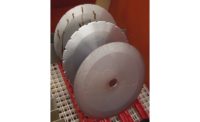
By Andy Hanacek, editor-in-chief, and Sam Gazdziak, editor, Independent Processor
Cured and cooked meats are the lifeblood of many processors, and a smokehouse that produces consistent and appetizing products is well worth the cost of purchase and upkeep.
Marc Gaddis, vice president of R&D for Sadler’s Smokehouse, says the No. 1 challenge with ovens and smokehouses is to maximize yield while minimizing the cold spots that can harm the product’s safety. Sadler’s considers itself the leader in brisket and Texas-style barbecue products, using an old-fashioned cooking/smoking process, and it has driven the company’s success over the years. Still, the company knows the rigors its process unleashes upon equipment, Gaddis says, and believes improvements can be made.
“[Machinery needs] robust controls and electronics — meat equipment is hit hard with harsh chemicals, harsh sanitation processes and harsh temperature differences,” he explains. “The equipment we rely on has to be extremely robust, particularly the electronics.”
Glen Meskimen is a former executive at Iowa Ham, which was acquired by Tyson, and a current industry consultant. He recommends that processors find smokehouses with flexibility, allowing them to modify racks to cook more types of products. Cooking systems that have brine-chill systems are a good option for processors who want to expand their cooked-meat operations.
For his part, Meskimen recommends using atomized liquid smoke instead of natural smoke for improved efficiency.
“There has been a lot of progress in liquid smoke companies,” he says. “They will make you a product that you can atomize in your smokehouse, and you will not be able to tell the difference between actual wood product versus the liquid smoke product.”
Meskimen says the liquid smoke process gives a more consistent covering on the products, and it still allows a processor to state that the product is naturally hardwood smoked, as the liquid smoke companies make their products from wood.
Jon Frohling, owner of Frohling Meats Inc., located in Hecla, S.D., says he learned smokehouse operation from hiring an experienced operator and from networking through associations. Now, he teaches courses at North Dakota State University and South Dakota State University.
He cautions processors to look for equipment that can be repaired easily, adding that some German-made equipment is good, but ordering parts can be a hassle.
“I can make these machines run by going to the hardware store,” he says, “My machines, even older ones, were never down for more than a day for repairs.” Little things, like making sure wet socks are changed periodically and checking the humidity levels are keys to making sure a processor gets perfect product every time, Frohling adds.
Meskiman recommends working with suppliers to fine-tune the equipment. Along with the equipment manufacturers, representatives from the liquid smoke and casing companies are also well-versed in smokehouse technology.
“Those people will all help you make a high-quality product at the least possible cost in those houses,” he says.
Independent Processor is sister publication in the BNP Media portfolio. Portions of this story appeared in an earlier issue of Independent Processor.

Report Abusive Comment